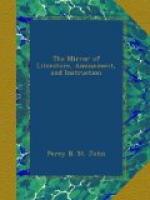But the state purposes to which the Seven Towers are appropriated boast of comparative comfort, “the prisoners detained here being distinguished from all other prisoners of war by an allowance for the table which is assigned them by the sultan, and by the appellation of mouzafirs, or hostages.[1] It may, indeed,” continues our traveller, “be considered as a great favour to be regarded in this light, comparing their situation with that of others, who fall into captivity among the Turks.” Moreover, this castle is dignified as an imperial fortress, and governed by an aga with a guard and a band of music. Indeed, we suppose it a sort of lock-up house preparatory to more rigorous confinement; and its governorship is a peaceable and honourable post. The Turks who compose the garrison of the Seven Towers have, in the first place, the advantage of being esteemed persons of a certain distinction in their quarter; and, secondly, they are exempted from going out to war, to which every Musselman is liable.
[1] Probably on the plan of
the lord mayor’s household table.
Well, Swift is right in supposing
the great art of life to be
that of hoaxing.
This castle stands at the eastern extremity of the Propontis, or Sea of Marmara; it is a tolerably regular pentagon, four out of the five angles of which are flanked by towers; the fifth angle had also a tower, but it exists no longer. Its principal front is towards the west, and has, besides the tower at one of the angles, two others, which stand on each side the ancient triumphal arch of Constantine. The gate of entrance to the Seven Towers on the side of the town is to the east, in a small square. The longest side of the pentagon is that in which Constantine’s arch is included; while towers existed at all the angles, this side presented a front of four towers; but it has now only three. The first marble tower is an enormous mass, between eighty and ninety feet high.
The triumphal arch of Constantine, which occupies the centre between the two marble towers, conducts to the golden gate in the exterior enclosure of the castle. The arch was more than ninety feet in height; but it has been so much injured by artillery, that no idea can now be formed of its ornaments. In the second marble tower is the Cave of Blood: the first door by which it is entered is of wood; this opens into a corridor of twelve feet long by four feet wide, having at the end two iron steps ascending to an iron door, and this leads into a semicircular gallery; at its furthest extremity is a second iron door, which completes the gallery, and ten feet further an immense massive door enclosing the dungeon. In the midst of this sarcophagus is a well, the mouth of which is level with the ground, and half closed by two flag-stones; to this is given the name of the well of blood, because the heads of those who are executed in the dungeon are thrown into it. In the same tower with this dungeon is a staircase leading up to a number of cells; from some of them, which are higher than the ramparts, the eye may be gratified with a view over Constantinople through loop-holes pierced in the walls. Here the Turks formerly used to confine those whom they call mouzafirs, or hostages; but the latter have now the choice allowed them of hiring more eligible apartments.




